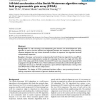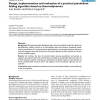53 search results - page 6 / 11 » Is the protein folding an aim-oriented process |
BMCBI
2006
13 years 8 months ago
2006
Background: In order to maintain the most comprehensive structural annotation databases we must carry out regular updates for each proteome using the latest profile-profile fold r...
BMCBI
2008
13 years 8 months ago
2008
Background: As one of the most common protein post-translational modifications, glycosylation is involved in a variety of important biological processes. Computational identificat...
BMCBI
2007
13 years 8 months ago
2007
Background: To infer homology and subsequently gene function, the Smith-Waterman (SW) algorithm is used to find the optimal local alignment between two sequences. When searching s...
BMCBI
2004
13 years 7 months ago
2004
Background: The general problem of RNA secondary structure prediction under the widely used thermodynamic model is known to be NP-complete when the structures considered include a...
LBM
2007
13 years 9 months ago
2007
Background: Extracting Protein-Protein Interactions (PPI) from research papers is a way of translating information from English to the language used by the databases that store th...


